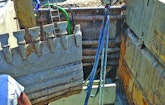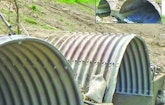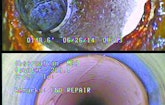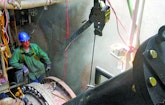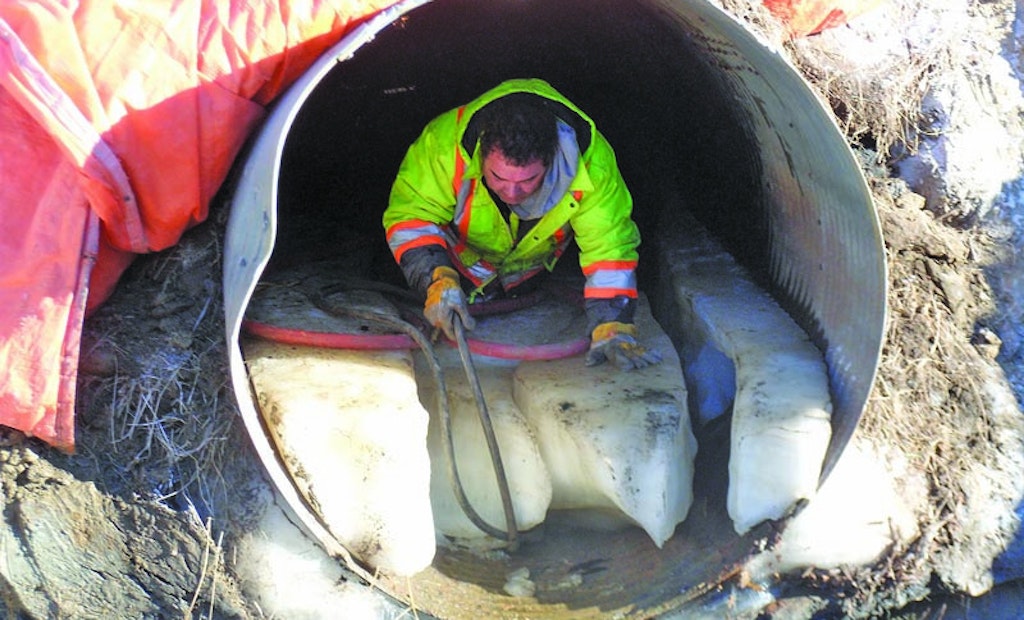Interested in Rehab/Relining?
Get Rehab/Relining articles, news and videos right in your inbox! Sign up now.
Rehab/Relining + Get AlertsHighway department rehabilitates culverts during polar vortex
Problem: In January and February 2014, one of the coldest winters in history, the Saskatchewan Department of Highways and Infrastructure contracted with Winnipeg-based MuddRuckers Inc. to complete a culvert rehabilitation project. The project consisted of four large culverts in separate locations. One was a round, 5-foot-diameter, 130-foot-long pipe. The other three were arched, about 80 feet long, with one 72 inches wide and 42 inches tall, and two that were 102 inches wide and 72 inches tall. All were corrugated metal and the two largest had deep indentations. All were failing; they were badly rusted, some sections of invert were rotting out and some culvert sections were misaligned.
Solution: MuddRuckers’ bid was based on a Centripipe centrifugally cast pipe rehabilitation system from AP/M PERMAFORM the department had used for previous culvert rehabilitation projects. The cost-effective process utilizes a precisely controlled spincaster to apply multiple thin layers of high-strength cementitious grout, creating a brand-new concrete pipe within the old pipe or sewer, while minimizing impact on flow capacity. The challenge was completing the work in arctic-cold temperatures. A week before rehabilitation began, 350,000 Btu heaters were brought to the sites, along with ground thaw heaters, to gradually raise culvert temperatures to about 68 degrees F, the optimum temperature for curing.
Result: After rehabilitation was complete, the heaters were kept in place for a week to facilitate proper curing. By rotating the heaters from site to site, and working on multiple sites, the entire project was successfully completed in six weeks. 800/662-6465; www.centripipe.com.
Internal joint seals solve problem without excavation
Problem: A 2013 Wisconsin DOT project to reconstruct a stretch of Highway 164 in Racine County was completed by late in the year. In a wetland area, there were settlement issues where twin 30-inch RCP stormwater culverts crossed under the roadway. The settlement caused the RCP culvert to move, and some joints opened up, allowing soil to migrate in.
Solution: The DOT contacted a local rehab contractor, Visu-Sewer Inc., who contacted Cretex Specialty Products and inquired about the Cretex/HydraTite Internal Joint Seal. The seals were chosen because they could be installed at the defective joints without digging and with easy man entry on the open-ended culverts. A total of four (two in each RCP culvert) 30-inch seals were installed and the contractor performed injection grouting to stabilize the soil around the outside of the joints.
Result: The joints have remained sealed according to specifications. 800/345-3764; www.cretexseals.com.
Pipe renovation system provides structural rehab
Problem: The City of Baltimore planned to rebuild Central Avenue, which included a structural rehabilitation of 3,275 feet of 100-year-old brick/stone storm drain that ranged in width between 9 to 20 feet and heights from 3.8 to 6.5 feet before lining. Low headroom posed challenges working in tight, confined spaces. Because there were areas of structural deficiency in the culvert, the storm drain rehab had to be completed before excavating the old street pavement and putting any new loads on top of it.
Solution: The city chose Grout-In-Place-Liner from Danby, installing 1-inch PL-IIIE panels, extensive reinforcing steel and grout with thicknesses averaging 12 to 24 inches. A total of 4,400 cubic yards of grout was used for the project. The 28-day test cubes consistently broke at 9,000 to 10,000 psi. The contractor, Boyer Inc., had the reinforced steel, liner, numerous service connections and grout successfully installed ahead of schedule.
Result: The storm culvert will support current and future traffic loads. The corrosion-resistant pipe has an increased hydraulic capacity in spite of the reduced cross-section due to the smooth surface and is expected to function for another 100 years. The City of Baltimore, design engineers and the construction managers were pleased with the final product. 281/598-1126; www.danbyrehab.com.
Florida contractor utilizes shoring to install sewer utility in wet excavation
Problem: Contractor Keystone Excavators was low bidder to install a heavy precast stormwater filtration vault for the City of Dunedin, Fla., as part of the city’s President Street Drainage Project. Throughout the project, groundwater in the excavation was an ongoing problem that had to be managed. Keystone employed a 4-inch submersible hydraulic pump and then a second 6-inch pump to keep the water manageable in the bottom of the hole.
Solution: Keystone used a 349 CAT Excavator to excavate a 28- by 16- by 16-foot-deep pit and set three stacked 6- by 2-foot Efficiency Production trench boxes to shore the excavation. The trench boxes were manufactured HT8 steel trench shields with 8-inch sidewalls. Keystone also rented road plate from Efficiency, which it used to shore the ends of the pit.
Result: The project was completed as planned with no incidents. “Efficiency has what we need for every application without having to give a month’s notice to get equipment,” says Keystone’s general superintendent Jeff Truxton. “It’s on the job site when we need it and they provide the support we need to get the job done.” 800/552-8800; www.efficiencyproduction.com.
CIPP lining system used to line faulty culvert underneath highway
Problem: The Ohio Department of Transportation had an 18-inch galvanized culvert, approximately 87 feet long, running under a state highway located in Warren County. The culvert had several holes as a result of deterioration and was washing out. Due to its location under a highway, replacement would have involved removal of asphalt and closure of the highway for an extended period of time.
Solution: A certified Flow-Liner Systems installer prepared the culvert and installed a CIPP lining system in the 18-inch culvert.
Result: The culvert was successfully lined in one day with minimal disruption to traffic. 800/348-0020; www.flow-liner.com.
Spray-applied liner used to restore highway culverts
Problem: Two culverts under I-280 near Toledo, Ohio, were showing signs of deterioration after decades in service. Though the concrete bottoms and corrugated, galvanized steel arches were still structurally sound, seam bolts on top of the arches had corroded and some steel was rusted. Advanced Rehabilitation Technology won the Ohio Department of Transportation subcontract to repair the damage. As the culverts were large (11 feet wide, 7 feet tall and approximately 132 feet long), a dig-and-replace solution would have been prohibitively costly, time-consuming and disruptive to traffic.
Solution: Instead, ODOT specified lining the culverts with PolySpray SS100 from HydraTech Engineered Products, a spray-applied polyurea-based system that is impervious to chemicals and abrasion. Preparations included dewatering each pipe, diverting the water flow, and pressure blasting the surfaces with grit and water to remove debris and old coatings. The contractor then lined the inside of each pipe with a 300-mil layer of PolySpray. The project took less than two weeks to complete and the culverts were returned to service the day after.
Result: In 13 calendar days, for a fraction of the cost of replacement, the Department of Transportation added 50 years to the serviceable life of two culverts under a busy highway. 513/827-9169; www.hydratechllc.com.
Point repair system restores three damaged areas in sewer main
Problem: In June 2014, Mid-Mo Environmental of Jefferson City, Mo., cleaned and televised sewer mains in the nearby Callaway County town of New Bloomfield. Many of these lines are under the streets and buried in excess of 10 feet deep. While televising one such line, they assessed a lateral crack, an abandoned tap and a bad joint all within a 6-foot-2-inch span, causing severe inflow and infiltration issues. The pipe was an 8-inch reinforced truss pipe installed in the 1970s.
Solution: Mid-Mo decided to use a trenchless point repair system from Infrastructure Repair Systems to restore the three damaged areas with a single 7-foot spot repair. Since the repair was within 24 feet of the near end of the manhole, owner Shawn York devised a 3/4-inch PVC pushrod to push the Logiball carrier and liner into place.
Result: The pushrod saved the time of jetting and stringing the entire 375-foot line and pushed the carrier with the resin-soaked fiberglass and felt liner in position to cover all three damaged areas. This single repair saved the town a significant amount of money by covering three areas with one long point repair, without digging or repaving the street. The installation was completed in less than three hours without any disruption of service to customers or the environment. 877/327-4216; www.irsi.net.
Fast-curing polymer lining system rehabilitates corroded concrete pipe
Problem: The SD342 Wood Street, Phase II Project from the East Bay Municipal Utility District (EBMUD) in Oakland, Calif., included rehabilitating approximately 6,200 feet of a severely corroded 105-inch-diameter concrete pipe, which had lost structural integrity. This pipeline conveys most of the influent flow into the 168 mgd treatment plant, which serves approximately 650,000 residents along the eastern shore of San Francisco Bay. It is also used as wastewater storage for flow equalization purposes.
Solution: Due to budget, risk and schedule concerns, the work had to be performed at night, during low flows and without bypassing. Since the pipeline runs under a residential area, the installation had to proceed without disturbing the neighbors, keep noise levels at or below 65 dB and keep hydrogen sulfide emissions undetectable. EBMUD and its consulting engineer, Brown and Caldwell, chose to continue the rehabilitation with the same fast-curing Pipeline Structural Polymer Co-Lining System from Linabond that was used successfully in 2000 for Phase I.
Result: The Phase II Project was awarded to J.R. Pipeline, which completed the first section, achieving liner installation rates of up to 1 linear foot per minute. The remainder of the project was completed in late 2014. 805/484-7373; www.linabond.com.
Plug stop enables oil refinery to continue operation during line replacement
Problem: An oil refinery in Baton Rouge, La., needed to repair a corroded caustic and catalyst line that had complete joint failure. Tight working conditions prevented use of bulky conventional line stop equipment. The unit could not be shut down. The 150 psi line required a plug that could handle 300 psi inflation pressures.
Solution: TEAM Industrial Services purchased two custom-designed plugs (one for backup) from Petersen Products. The plugs were manufactured using ballistic nylon made impermeable and corrosion resistant with ethylene propylene diene monomer. TEAM coordinator Scott Lominac’s priorities included testing the plug and insertion procedure before live insertion and inflation. To perform rigorous testing in conditions that closely simulated actual plant conditions, TEAM built a “test vessel” that modeled the pipe configuration on its premises.
Result: During testing, the plugs held up well, and the completed project was a solid success. Lominac expects to keep using plugs at high pressures. 800/926-1926; www.pipeplug.com.
CIPP used to repair leaking overflow joint
Problem: Alpine Lake Resort in Terra Alta, W.Va., needed to rehabilitate a leaking overflow joint. The top of the flowing pipe was compromised due to a failed leaking overflow joint, allowing water to infiltrate the overflow pipe continuously. Thus, the lake was losing water every day beyond desired levels.
Solution: The PipePatch cured-in-place pipe process from Source One Environmental was chosen. A Flow-Thru Packer was used because of its range within a pipe and precise alignment for the repair. On the day of the repair, the dam’s flow levels made it impossible to retrieve measurements for the packer’s placement. Additionally, the overflow pipe access point could only be reached by boat and the team navigated to the repair area with equipment. Limited sandbags and makeshift water bags were designed out of packer protective sleeves, utilized to slow the cascading water from entering the drainpipe and control water flow.
Result: A post-repair inspection revealed that the infiltration was completely sealed off. PipePatch cured the leaking joint without excavating, pre-grouting, DEQ permitting or causing disruption within the resort, and because of the trenchless technology, the resort was able to maintain its water level and defer negative impacts. 877/450-3701; www.s1eonline.com.


